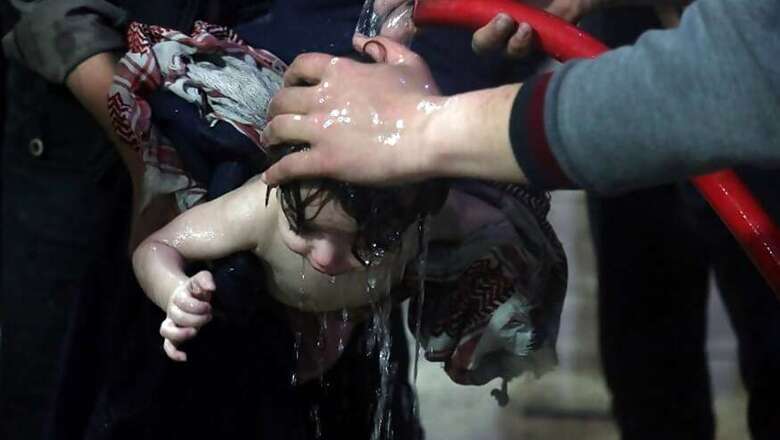
views
Washington: The United States, France and Britain launched 105 missiles on Saturday targeting what the Pentagon said were three chemical weapons facilities in Syria, in retaliation for a suspected poison gas attack in the Syrian town of Douma on April 7.
Here is the information the Western countries say they have about the suspected Syrian poison gas assault on Douma.
UNITED STATES
In a conference call with reporters on Saturday, senior U.S. administration officials said they had a large volume of clear and compelling information, both of chemical weapons use and of President Bashar al-Assad's culpability in the attack. "The information we have points to the use of both chlorine and sarin, both of which are chemical weapons," one official said.
The officials said they had videos and photos showing the remnants of at least two chlorine barrel bombs from the attacks with features consistent with chlorine barrel bombs from past attacks.
Photographs and video from Douma documented victims suffering from symptoms consistent with exposure to toxic chemicals, such as asphyxiation and foaming at the mouth, the officials said.
Eyewitnesses reported multiple government helicopters over Douma on April 7th, and said barrel bombs were dropped from those helicopters, the officials said. They said the only forces with military aircraft such as helicopters in Syria belong to Assad's government.
Doctors and aid organizations on the ground reported strong smells of chlorine, and described symptoms consistent with exposure to sarin, the senior US officials said.
The officials said that while the available information is much greater on the chlorine use, they also had significant information that also points to use of sarin, which is a nerve agent. Symptoms such as convulsions, in addition to the dozens of deaths and hundreds of injuries reported, suggest sarin, which is a much more efficient weapon, they said.
Pentagon officials on Saturday said they "assessed" that there were probably both chemical and nerve agents in the targets US forces hit with missile strikes, but added that they had "successfully mitigated" against this in the way they attacked them.
FRANCE
France concluded after technical analysis of open sources and "reliable intelligence" that a chemical attack on Douma on April 7 was carried out by Syrian government forces, a declassified intelligence report said on Saturday.
"On the intelligence collected by our services, and in the absence to date of chemical samples analysed by our own laboratories, France considers, beyond possible doubt, a chemical attack was carried out against civilians at Douma ... and that there is no plausible scenario other than that of an attack by Syrian armed forces," the report said.
"After examining the videos and images of victims published online, they (intelligence services) were able to conclude with a high degree of confidence that the vast majority are recent and not fabricated," the report said.
It said no deaths from mechanical injuries were visible and all symptoms were characteristic of a chemical weapons attack, particularly choking agents and organophosphorus agents or hydrocyanic acid.
"Reliable intelligence indicates that Syrian military officials have coordinated what appears to be the use of chemical weapons containing chlorine on Douma, on April 7," the report said. It gave no other details on the intelligence.
WHAT HAPPENS NOW?
International officials are working to try to confirm the suspected poison gas attack on Douma. Inspectors from the global chemical weapons watchdog OPCW were trying over the weekend to reach sites related to the suspected poison attack in Douma.
The inspectors met Syria's deputy foreign minister in the presence of Russian officers and a senior Syrian security official; they were due to attempt to visit the Douma site.
Despite a US-Russian agreement to completely eliminate Syria's chemical weapons program after hundreds of people were gassed with sarin in Ghouta on Aug. 21, 2013, the OPCW had been unable to verify that all manufacturing, storage and research facilities were destroyed.
OPCW stands for the Organization for the Prohibition of Chemical Weapons. It is to determine whether chemical weapons were used, but will not assign blame.
A United Nations-OPCW Joint Investigative Mechanism also looked at responsibility for chemical weapons use. It concluded in 2016 that Syrian government forces had several times used chlorine as a chemical weapons, and in 2017 it blamed Assad's government for a sarin attack. It blamed Islamic State militants for mustard gas use.
But the joint UN-OPCW mechanism ended in November 2017 after Russia repeatedly blocked attempts at renewing it. The Security Council is deadlocked over how to replace it.
About 45 human rights and aid groups urged U.N. Secretary-General António Guterres on Friday to appoint a team of independent investigators to determine blame for toxic gas attacks in Syria.
France, the United States and Britain circulated a draft resolution to the UN Security Council late on Saturday that aims to establish a new independent inquiry into who is to responsible for chemical weapons attacks in Syria.




















Comments
0 comment